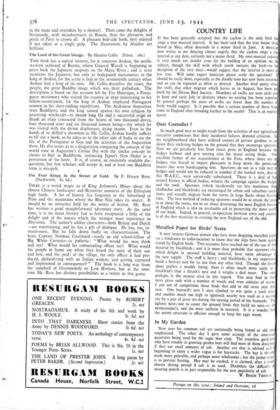COUNTRY LIFE
IT has been generally accepted that the cuckoo is the only bird that sings a true musical interval. It has been saidthat the true major third, heard in May, often descends to a minor third in June. A musician now writes to me denying almost angrily that the cuckoo sings a true interval at any date, certainly not a major third. My own musical capacity is very much too slender even for the holding of an opinion on the subject, though the skill with which youth imitates the bird—to the deception of the very elect—would suggest that the interval is more a less true. Will some expert musician please settle the question? It should be easily done, especially as the double note has now been recorded and so can be repeated as often as desired. Another bird query about the swift, that other migrant which leaves us in August,' has been put forth by the Devon Bird Society. Numbers of swifts are seen each year in June and early July in districts where no nesting has been reported In general perhaps the nests of swifts are fewer than the number of birds would suggest. Is it possible that a certain number of these birds come to England after breeding further to the south? That is an expert's query.
Quis Custodiet ? 4.
So much good may or might result from the activities of war agricultural executive committees that their incidental failures demand criticism. In my neighbourhood they have ordered owners .of private gardens to cut down their enclosing hedges on the ground that they encourage sparrows. Now we are peculiarly free from insect pests in England because the hedges harbour and give nesting sites for insect eating birds. One excellent farmer of my acquaintance an the Fens, where there are no hedges, was forced to import pheasants to keep down the pernicious insects that were handicapping him. Sparrows do not as a rule nest in hedges and would not be reduced in number if the barbed wire, dear to this W.A.E.C., were universally substituted. There is a deal of bad natural history in official bodies, witness the campaign against the badger and the rook. Sparrows (which incidentally are less numerous than chaffinches and blackbirds) are encouraged by urban and suburban condi- tions, and actually migrate from the towns in large flocks about harvest time. The best method of reducing sparrows would be to attack the nest in or about the towns, not to set about destroying the most English featur. of England which is also an invaluable aid in preserving the most usef. of our birds. Indeed, in general, co-operation between town and coun::. is of the first necessity in creating the new England out of the old.
Metalled Paper for Birds' Nests It may interest German airmen who have been dropping metalled p3P. (as a hindrance to radio-location) to know that the slips have been apPr, ciated by English birds. Two accounts have reached me of the use of th material by blackbirds ; and it is more than probable that sparrows al,' which delight in unusual building material, have taken advantage the new supply. The stuff is heavy ; and blackbirds, in my experien,: build a heavier nest for its size than any other bird. Though the thru, alone prefers a muddy lining, there is often much more earth in blackbird's than a thrush's nest and it weighs a deal more. The rook, perhaps, is the- nearest rival in this regard. You may find in their nests grass sods with a number of weeds and even colonies of worms. I put out of competition those birds that add to old nests year after year. One buzzard's nest I once climbed to was quite a yard deep; and another much too high to approach nearby was used as a nesn site by a pair of great tits during the nesting period of the 131,77JArds. Th lightest nest—not to count the ground birds that build no nest—is th nettlecreeper's, and the most uniform in material. It is a wonder h the aertex structure is efficient enough to keep the eggs warm.
In My Garden New uses for common salt are continually being found or old ono emphasised. The other day I gave some account of the enormous quantities being used for the sugar beet crop. The countless gardeners who have trouble in growing garden beet will find most of them disappear if they use small amounts of salt. Another use that is advised and is beginning to enjoy a wider vogue is for haystacks. The hay is there'll made more palatable, and perhaps more wholesome ; but the prime obina is to prevent heating. Hay may be stacked, it is claimed, after a mud' shorter drying period if salt is so used. Doubtless the difficulty securing potash is in part responsible for the new popularity of salt.
W. BEACH THOMAS.
Postage on this issue : Inland and Overseas, Id






















 Previous page
Previous page